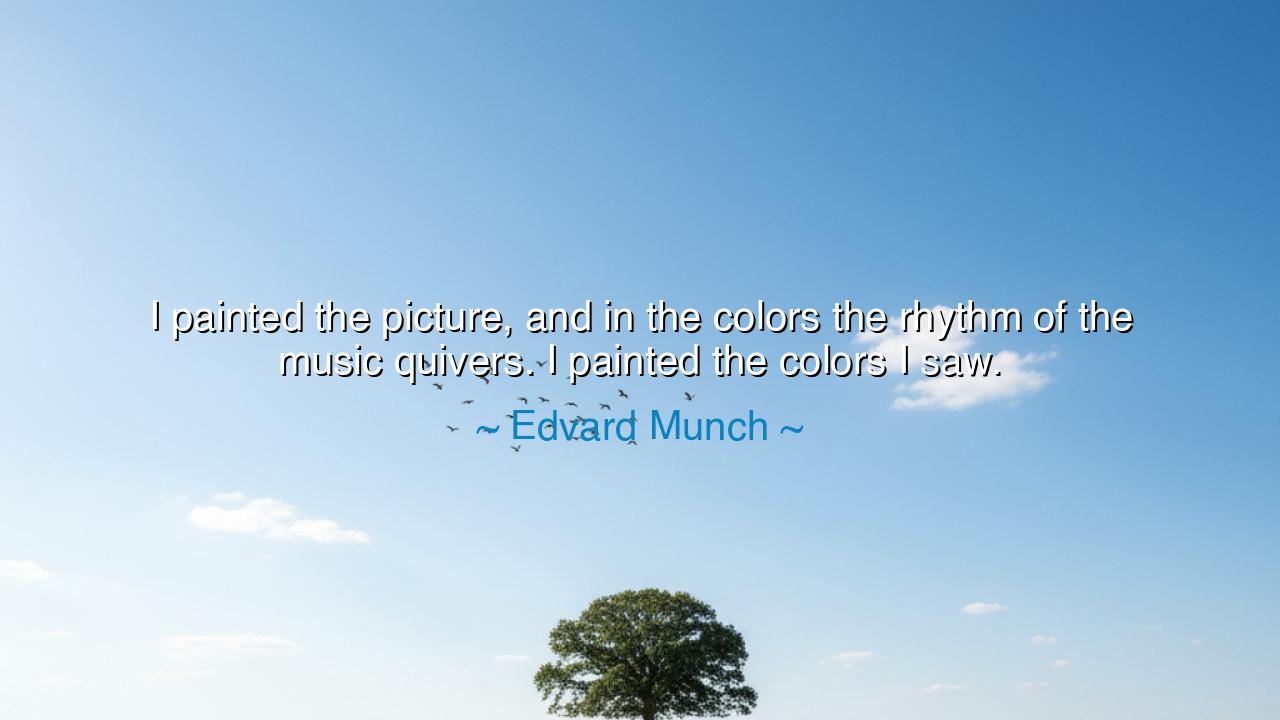
I painted the picture, and in the colors the rhythm of the music
I painted the picture, and in the colors the rhythm of the music quivers. I painted the colors I saw.






Hear the voice of the painter of souls, Edvard Munch, who declared: “I painted the picture, and in the colors the rhythm of the music quivers. I painted the colors I saw.” These words do not belong to the realm of mere craft; they are the testimony of a man who sought to capture the trembling spirit of life itself upon canvas. In his vision, music, unseen yet deeply felt, found form through the trembling of colors. His art was not simply to reproduce the world, but to reveal what quivered beneath it—the pulse, the vibration, the essence of human emotion.
For Munch, the act of painting was not only of the eye but of the ear, the heart, the soul. He reminds us that art is a union of the senses, where boundaries dissolve: color becomes sound, and sound becomes movement. Just as a melody can awaken sorrow or joy, so can hues on a canvas sing or cry. In his statement, he reveals the inner fire that guided his brush—the conviction that the invisible rhythm of existence must be given visible form.
Consider his most famous work, The Scream. It is not a simple landscape nor a portrait of a figure. It is a painting that quivers with soundless terror, where even the sky howls in hues of red and orange. Here, we see the truth of his words: the colors quiver like music, vibrating with anguish and intensity. Munch did not merely depict a scene; he allowed his senses to merge, to translate sound into sight, to paint not the world as it is, but as it feels within.
This way of seeing is not Munch’s alone. History offers us the story of Ludwig van Beethoven, who though deaf, composed symphonies of eternal beauty because he saw the sounds in his mind. His music quivered within him though silence surrounded him. Likewise, Munch heard the rhythm in colors and brought it forth into his paintings. Both men remind us that human perception is not confined; it is expansive, able to bridge worlds and unite senses when guided by passion and vision.
The meaning of Munch’s words is profound: creativity lies not in imitation but in translation—translating emotions into symbols, sounds into colors, rhythms into shapes. The artist’s task is to reveal the hidden harmony of existence, to make tangible what the spirit feels but cannot name. Colors and music are not separate realms but two languages speaking of the same truth.
The lesson for us is this: do not confine yourself to the narrow borders of one sense, one skill, one path. Open yourself to the union of experiences. Let music inspire your words; let images guide your songs; let emotions shape your craft. To create is to listen with more than ears, to see with more than eyes, to feel with the wholeness of being. Like Munch, we must dare to paint the colors we see, even if others cannot yet perceive them.
Practical steps lie close at hand. When you listen to music, notice the colors it stirs in your imagination. When you look upon colors, feel the rhythms they suggest. Write, draw, sing, or move from those sensations, letting one art awaken another. Do not worry about perfection; focus instead on honesty of expression. By doing so, you will find that your life itself becomes a canvas where the invisible finds voice and the intangible takes form.
Thus, let the words of Edvard Munch endure as a beacon: “I painted the picture, and in the colors the rhythm of the music quivers.” Take this as your guide, that in your own creations—whether humble or grand—you may reveal the quivering spirit of life, and let your work speak to future generations with the resonance of both sight and song.






AAdministratorAdministrator
Welcome, honored guests. Please leave a comment, we will respond soon